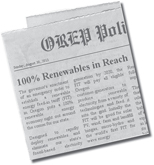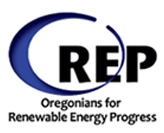Committee Chairs Propose Wisconsin Feed-in Tariff Legislation
December 16, 2009
By Paul Gipe
In a potentially groundbreaking development in the Midwest, the committee chairs of both the House and Senate of Wisconsin's state legislature have proposed a comprehensive package of climate change legislation. Included in the massive overhaul of the state's energy policy is legislation creating a system of feed-in tariffs.
The proposal incorporates the recommendations of Governor Jim Doyle's task force on global warming in mid 2008.
Observers of Wisconsin's legislature note that when the chairs of both the House and Senate's committees on utilities and natural resources introduce the same legislation, the bill is likely to pass "in some form" and be signed by Governor Doyle this coming session.
Legislation calling for feed-in tariffs is also expected to be introduced in the coming legislative sessions in Minnesota, Michigan, and Indiana. However, in no other Midwestern state is the political alignment for feed-in tariffs as favorable as that in Wisconsin where the same party controls both the House and Senate and the Governor is likely to sign the legislation.
Of interest are proposed changes to Wisconsin's Renewable Portfolio Standard that requires 10% of the state's generation come from in-state renewables. According to RENEW Wisconsin's <http://www.renewwisconsin.org> Michael Vickerman, this requirement is equivalent to 7 TWh per year.
For a sense of scale, 7 TWh per year would require the installation of 7,000 MW of solar PV or 3,500 MW of wind generating capacity under Wisconsin conditions. In comparison, the target for California's much maligned solar initiative is only 3,000 MW of solar PV.
Below are some of the key design features included in the proposed legislation, though much of the detailed program design is assigned to the Public Service Commission.
Includes most renewables
Tariffs differentiated by technology
Tariffs based on cost of generation plus a "reasonable rate of return"
Tariffs may be further differentiated by project size
Tariffs to include state or federal subsidies
Project size caps
Periodic review
However, several utilities, such as rural co-ops, are exempted from provisions of the legislation and utilities may continue to use their existing feed-in tariff programs if they are "consistent with the purposes of these provisions".
Several Wisconsin utilities have extremely limited feed-in tariffs that have been largely ineffectual.
LRB-3883/1 Status <http://www.legis.state.wi.us/lc/publications/climate/index.htm>
Description of Legislation <http://www.legis.state.wi.us/lc/publications/climate/files/Description-LRB-3883_1.pdf>
-End-
In Other Feed-in Tariff News
Committee Chairs Propose Wisconsin Feed-in Tariff Legislation--In a potentially groundbreaking development in the Midwest, the committee chairs of both the House and Senate of Wisconsin's state legislature have proposed a comprehensive package of climate change legislation. Included in the massive overhaul of the state's energy policy is legislation creating a system of feed-in tariffs. . .
Deutsche Bank: Paying for Renewable Energy: TLC at the Right Price <http://www.dbcca.com/dbcca/EN/_media/Paying_for_Renewable_Energy
_TLC_at_the_Right_Price.pdf> --Germany in particular stands out and is able to demonstrate many benefits that come with a strong volume response while being responsive to significant market developments. In a North American context, the province of Ontario has many features of a strong policy design. . .
NW Energy Coalition Passes Resolution in Support of FITs <http://www.wind-works.org/FeedLaws/USA/NWEnergyCoalitionPassesResolutioninSupportof
FITs.html> --The Northwest Energy Coalition passed a resolution in support of feed-in tariffs at its annual conference on November 14, 2009 in Seattle, Washington. . .
Italian Groups: 8,000 MW PV in Five Years <http://www.wind-works.org/FeedLaws/Italy/Italian%20Groups8000MWPVinFiveYears.html> --Three Italian trade associations have called on the government to update its system of solar PV feed-in tariffs to install 8,000 MW of new capacity by 2015. . .
The clean energy potential in our backyard <http://www.sfgate.com/cgi-bin/article.cgi?f=/c/a/2009/12/08/ED2U1B0MM8.DTL> --State Assembly Member Nancy Skinner says California should expand and improve the so-called "feed-in tariff" program . . .
Al Rosen's Letter to the LA Times on feed-in tariffs article 12 12 09 <http://www.wind-works.org/FeedLaws/USA/Al%20RosenLettertotheLATimesonfeed-
in%20tariffs.html> --I think the public should be aware of some of the sad facts about California?s inadequate FIT program . . .
LA Times: Germany shows government role is key to thriving solar industry <http://www.latimes.com/news/nation-and-world/la-fg-climate-solar12-
2009dec12,0,3881677.story> --The nation has become the world's top leader in solar energy precisely because it did not leave the task of harnessing the sun to solely the private sector. . .
Algerian Feed-in Tariff Decree 2004 <http://www.wind-works.org/FeedLaws/Algeria/AlgerianFeed-inTariffDecree2004.html> --The Algerian government instituted a feed-in tariff in the spring of 2004. The policy appears modeled after that used in Spain at the time. . .
This feed-in tariff news update is partially supported by the Jan David Blittersdorf Foundation in cooperation with the Institute for Local Self Reliance. The views expressed are those of Paul Gipe and are not necessarily those of the sponsors.
Paul Gipe


